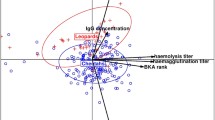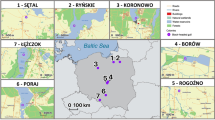Abstract
The general development of immune response in the short and long term is a product of the antigenic environment in which a species resides. Colonization of a novel antigenic environment by a species would be expected to alter the immune system. Animals that successfully adapt their immune responses will successfully colonize new locations. However, founder events associated with colonization by limited numbers of individuals from a source population will constrain adaptability. How these contradicting forces shape immunity in widely distributed species is unknown. The western house mouse (Mus musculus domesticus) spread globally from the Indo-Pakistani cradle, often in association with human migration and settlement. In the present study, we tested the hypothesis that wild-derived outbred laboratory populations of house mice from their original range (Iran) and historically recent European invasive populations (from France and Germany) present differences in immune functional diversity corresponding to recent historical founder events in Europe and movement to novel antigenic environments. We found that (1) European mice had lower total white blood cell (WBC) counts but higher immunoglobulin E concentrations than their Iranian counterparts, and (2) there were no significant differences in the measured immunological parameters among European populations. The results indicate that founder events in European mice and selection pressure exerted by the composition of local parasitic helminth communities underlie the observed patterns.


Similar content being viewed by others
References
Allymehr M, Tavassoli M, Manoochehri MH, Ardavan D (2012) Ectoparasites and gastrointestinal helminths of house mice (Mus musculus) from poultry houses in Northwest Iran. Comp Parasitol 79:283–287
Aplin K, Ford F (2014) Murine rodents: late but highly successful invaders. In: Prins HHT, Gordan IJ (eds) Invasion biology and ecological theory: insights from a continent in transformation. Cambridge University Press, Cambridge, pp 196–240
Arim M, Abades SR, Neill PE, Lima M, Marquet PA (2006) Spread dynamics of invasive species. Proc Natl Acad Sci USA 103:374–378
Auffray JC, Britton-Davidian J (2012) The house mouse and its relatives: systematics and taxonomy. In: Macholán M, Baird SJE, Munclinger P, Piálek J (eds) Evolution of the house mouse. Cambridge University Press, Cambridge, pp 1–34
Baines JF, Harr B (2007) Reduced X-linked diversity in derived populations of house mouse. Genetics 175:1911–1921
Baired SJE, Ribas A, Macholán M, Albrecht T, Piálek J, de Bellocq JG (2012) Where are the wormy mice? A reexamination of hybrid parasitism in the European house mouse hybrid zone. Evolution 66:2757–2772
Benjamini Y, Hochberg Y (1995) Controlling the false discovery rate: a practical and powerful approach to multiple testing. J R Statist Soc B 57:289–300
Berry RJ (1986) Genetics of insular populations of mammals, with particular reference to differentiation and founder effects in British small mammals. Biol J Linn Soc 28:205–230
Bonhomme F, Searle JB (2012) House mouse phylogeography. In: Macholán M, Baird SJE, Munclinger P, Piálek J (eds) Evolution of the house mouse. Cambridge University Press, Cambridge, pp 278–296
Bonhomme F, Rivals E, Orth A, Grant GR, Jeffreys AJ, Bois PRJ (2007) Species-wide distribution of highly polymorphic minisatellite markers suggests past and present genetic exchanges among house mouse subspecies. Genome Biol 8:R80
Cesta MF (2006) Normal structure, function, and histology of the spleen. Toxicol Pathol 34:455–465
Chai CK (1970) Genetic basis of leukocyte production in mice. J Hered 61:67–71
Chen J, Harrison DE (2002) Quantitative trait loci regulating relative lymphocyte proportions in mouse peripheral blood. Blood 99:561–566
Corbin E, Vicente J, Martin-Hernando MP, Acevedo P, Pérez-Rodríguez L, Gortazar C (2008) Spleen mass as a measure of immune strength in mammals. Mammal Rev 38:108–115
Crowl TA, Crist TO, Parmenter RR, Belovsky G, Lugo AE (2008) The spread of invasive species and infectious disease as drivers of ecosystem change. Front Ecol Environ 6:238–246
Cucchi T, Vigne JD, Auffray JC (2005) First occurrence of the house mouse (Mus musculus domesticus Schwarz & Schwarz, 1943) in the Western Mediterranean: a zooarchaeological revision of subfossil occurrences. Biol J Linn Soc 84:429–445
Cucchi T, Auffray JC, Vigne JD (2012) On the origin of house mouse synanthropy and dispersal in the near East and Europe: zooarchaeological review and perspectives. In: Macholán M, Baird SJE, Munclinger P, Piálek J (eds) Evolution of the house mouse. Cambridge University Press, Cambridge, pp 65–93
Feliu C, López M, Gómez MS, Torres J, Sánchez S, Miquel J, Abreu-Acosta N, Segovia JM, Martín-Alonso A, Montoliu I, Villa M, Fernández-Álvarez Á, Bakhoum AJS, Valladares B, Orós J, Foronda P (2012) Parasite fauna of rodents (Murinae) from El Hierro (Canary Islands, Spain): a multidisciplinary approach. Acta Parasitol 57:171–178
Goüy de Bellocq J, Porcherie A, Moulia C, Morand S (2007) Immunocompetence does not correlate with resistance to helminth parasites in house mouse subspecies and their hybrids. Parasitol Res 100:321–328
Gray MM, Wegmann D, Haasl RJ, White MA, Gabriel SI, Searle JB, Cuthert RJ, Ryan PG, Payseur BA (2014) Demographic history of a recent invasion of house mice on the isolated Island of Gough. Mol Ecol 23:1923–1939
Hájek J, Šidák Z, Sen PK (1999) Theory of rank tests, 2nd edn. Academic, San Diego
Hufbauer RA, Torchin ME (2007) Integrating ecological and evolutionary theory of biological invasions. In: Nentwig W (ed) Biological invasions. Springer, Berlin, pp 79–96
Hulme PE (2009) Trade, transport and trouble: managing invasive species pathways in an era of globalization. J Appl Ecol 46:10–18
Keller RP, Geist J, Jeschke JM, Kühn I (2011) Invasive species in Europe: ecology, status, and policy. Env Sci Eur 23:23
Kia EB, Homayouni MM, Farahnak A, Mohebali M, Shojai S (2001) Study of endoparasites of rodents and their zoonotic importance in Ahvaz, South West Iran. Iran J Public Health 30:49–52
Lee KA, Klasing KC (2004) A role for immunology in invasion biology. Trends Ecol Evol 19:523–529
Lee KA, Martin LB, Wikelski MC (2005) Responding to inflammatory challenges is less costly for a successful avian invader, the house sparrow (Passer domesticus), than its less-invasive congener. Oecologia 145:244–251
Llewellyn D, Thompson MB, Brown GP, Phillips BL, Shine R (2012) Reduced investment in immune function in invasion-front populations of the cane toad (Rhinella marina) in Australia. Biol Invasions 14:999–1008
Manjerovic MB, Waterman JM (2012) Immunological sex differences in socially promiscuous African ground squirrels. PLoS One 7:e38524
Martin LB, Liebl AL, Kilvitis HJ (2015) Covariation in stress and immune gene expression in a range expanding bird. Gen Comp Endocrinol 211:14–19
Mebius RE, Kraal G (2005) Structure and function of the spleen. Nat Rev Immunol 5:606–616
Milazzo C, De Bellocq JG, Cagnin M, Casanova JC, Di Bella C, Feliu C, Fons R, Morand S, Santalla F (2003) Helminths and ectoparasites of Rattus rattus and Mus musculus from Sicily, Italy. Comp Parasitol 70:99–104
Milazzo C, Cagnin M, Di Bella C, Geraci F, Ribas A (2010) Helminth fauna of commensal rodents, Mus musculus (Linnaeus, 1758) and Rattus rattus (Linnaeus, 1758) (Rodentia, Muridae) in Sicily (Italy). Rev Ibero-Latinoam Parasitol 69:194–198
Møller AP, Sorci G, Erritzøe J (1998) Sexual dimorphism in immune defense. Am Nat 152:605–619
Mooney HA, Cleland EE (2001) The evolutionary impact of invasive species. Proc Natl Acad Sci USA 98:5446–5451
Morand S, Bordes F, Chen H-W, Claude J, Cosson J-F, Galan M, Czirják GÁ, Greenwood AD, Latinne A, Michaux J, Ribas A (2015) Global parasite and Rattus rodent invasions: the consequences for rodent-borne diseases. Integr Zool (in press). doi:10.1111/1749-4877.12143
Murphy K (2012) Janeway’s immunobiology, 8th edn. Garland Science, London
Pakdel N, Naem S, Rezaei F, Chalehchaleh AA (2013) A survey on helminthic infection in mice (Mus musculus) and rats (Rattus norvegicus and Rattus rattus) in Kermanshah. Iran. Vet Res Forum 4:105–109
Phillips BL, Brown GP, Shine R (2010) Life-history evolution in range-shifting populations. Ecology 91:1617–1627
Ponlet N, Chaisiri K, Claude J, Morand S (2011) Incorporating parasite systematics in comparative analyses of variation in spleen mass and testes sizes of rodents. Parasitology 138:1804–1814
R Development Core Team (2014) R: a language and environment for statistical computing. R Foundation for Statistical Computing, Vienna. http://www.R-project.org. Accessed 31 Oct 2014
Rajabi-Maham H, Orth A, Bonhomme F (2008) Phylogeography and postglacial expansion of Mus musculus domesticus inferred from mitochondrial DNA coalescent, from Iran to Europe. Mol Ecol 17:627–641
Rapp KG (1972) HAN-rotation, a new system for rigorous outbreeding. Z Versuchstierkd 14:133–142
Schulte-Hostedde AI, Elsasser SC (2011) Spleen mass, body condition, and parasite load in male American mink (Neovison vison). J Mammal 92:221–226
Simberloff D, Martin JL, Genovesi P, Maris V, Wardle DA, Aronson J, Courchamp F, Galil B, García-Berthou E, Pascal M, Pyšek P, Sousa R, Tabacchi E, Vilà M (2013) Impacts of biological invasions: what’s what and the way forward. Trends Ecol Evol 28:58–66
Suzuki H, Nunome M, Kinoshita G, Aplin KP, Vogel P, Kryukov AP, Jin M-L, Han S-H, Maryanto I, Tsuchiya K, Ikeda H, Shiroishi T, Yonekawa H, Moriwaki K (2013) Evolutionary and dispersal history of Eurasian house mice Mus musculus clarified by more extensive geographic sampling of mitochondrial DNA. Heredity 111:375–390
Swamy PM (2009) Laboratory manual on biotechnology. Rastogi, Meerut
Swan MP, Hickman DL (2014) Evaluation of the neutrophil–lymphocyte ratio as a measure of distress in rats. Lab Anim (NY) 43:276–282
Tian JD, Courtiol A, Schneeberger K, Greenwood AD, Czirják GÁ (2015) Circulating white blood cell counts in captive and wild rodent are influenced by body mass rather than testes mass, a correlate of mating promiscuity. Funct Ecol 29:823–829
Weir JA, Schlager G (1962) Selection for leucocyte count in the house mouse and some physiological effects. Genetics 47:1199–1217
White TA, Perkins SE (2012) The ecoimmunology of invasive species. Funct Ecol 26:1313–1323
Acknowledgments
We thank Diethard Tautz for providing access to samples from the house mice. We are grateful to Natascha Hasenkamp, Heike Harre, Christine Pfeifle, Heinke Buhtz, Cornelia Burghardt, and the mouse housing team from the Max Planck Institute for Evolutionary Biology, Plön as well as Katja Pohle from the Leibniz Institute for Zoo and Wildlife Research, Berlin for their technical and logistical assistance. Further thanks are due to Anca Dorhoi from the Max Planck Institute for Infection Biology for commenting on the immunological interpretation. J.D. Tian is supported by a Ph.D. scholarship from the China Scholarship Council (no. 2011704029). This research was supported by funds from the Leibniz Institute for Zoo and Wildlife Research.
Author contribution statement
ADG and GÁC conceived and designed the experiments. JT performed the experiments. JT and HH analyzed the data. JT, ADG, HH, and GÁC wrote the manuscript.
Author information
Authors and Affiliations
Corresponding author
Ethics declarations
Conflict of interest
The authors declare that they have no conflict of interest.
Additional information
Communicated by Pawel Koteja.
Electronic supplementary material
Below is the link to the electronic supplementary material.
442_2015_3397_MOESM1_ESM.doc
Fig. S1. Interactive effects of house mouse body mass and three sampling sites on the immunological variables measured. There are no obvious interactions of total WBC (a), IgE (b), IgG (c), and IgM (d) with body mass for French, German, and Iranian wild-derived outbred laboratory house mice. (DOC 106 kb)
Rights and permissions
About this article
Cite this article
Tian, J., Hofer, H., Greenwood, A.D. et al. Colonization history shaped the immunity of the western house mouse. Oecologia 179, 679–686 (2015). https://doi.org/10.1007/s00442-015-3397-0
Received:
Accepted:
Published:
Issue Date:
DOI: https://doi.org/10.1007/s00442-015-3397-0




